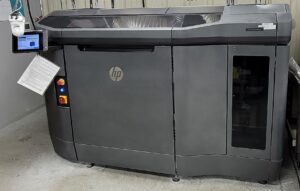SOLO Labs started investigating additive manufacturing (3D printing) fifteen years ago. In 2018, this method of orthotic production was added as an option, resulting in patient-specific custom orthotics that improve both the patient’s end result and reduced production costs.
SOLO still offers traditional manufacturing options, 3D printing offers significant benefits.
A typical orthotic starts with casting or scanning a patient’s feet, after which our Computer-Aided Design (CAD) process is used to create fully custom designs tailored to their specific anatomical and structural requirements. When a clinician requests a specific device, our CAD team adjusts the digital model to accommodate the patient’s feet, while also adding correction in specific areas as needed.
The orthotic shell is then produced from the digital design, and the final product is assembled with accommodations, pads, and top covers based on the desired patient outcome.
Traditional Orthotic Shell Manufacturing
Traditionally, functional orthotic shells are produced by pouring plaster molds or milling wood molds, followed by thermoforming. This process involves hand-pressing various flat materials into the desired shell shape using these molds. After cooling and demolding, the shells are trimmed and shaped using a combination of hand and machine tools. Extrinsic posting materials are then added as needed.
This manual process can introduce inconsistencies due to human variability and the thermoforming process itself, which can lead to dimensional changes from the intended design due to material contraction during cooling. This cooling can result in a narrower heel width and a slightly lower arch.
The traditional process for creating orthotics is quite labor intensive, resulting in added costs.
Advantages of 3D Printing
In contrast, 3D printing eliminates the need for molding, thermoforming, and manual finishing. Once the orthotic design is finalized, it’s sent to one of SOLO’s HP Multi Jet Fusion (MFJ) printers, which builds the orthotic shell in 0.08 mm thick layers from powder, achieving excellent dimensional accuracy and detail without material distortions. This process ensures that the final product precisely matches the intended design. If patients need a duplicate, the digital file is reprinted precisely, whether three months or three years later.
SOLO offers durable, skin-safe 3D printed shells in four flexibilities, similar to the options available with traditional polypropylene shell thicknesses. These 3D printed shells are guaranteed against breakage for life, paralleling the warranty for traditional polypropylene shells. To date, SOLO has printed over 100,000 orthotics, and stands behind every one.
The precision of SOLO’s CAD software, combined with 3D printing technology, sets a new standard for accuracy and repeatability, crucial for patient care.
SOLO Labs remains dedicated to adopting the latest technological advancements and to continuing the 40-year tradition of Serving Others Loving Others. This dedication has led to the production of exceptional custom orthotics that significantly improve and enhance the quality of life for patients.
Advantages of 3D Printing Custom Orthotics
SOLO Labs started investigating additive manufacturing (3D printing) fifteen years ago. In 2018, this method of orthotic production was added as an option, resulting in patient-specific custom orthotics that improve both the patient’s end result and reduced production costs.
SOLO still offers traditional manufacturing options, 3D printing offers significant benefits.
A typical orthotic starts with casting or scanning a patient’s feet, after which our Computer-Aided Design (CAD) process is used to create fully custom designs tailored to their specific anatomical and structural requirements. When a clinician requests a specific device, our CAD team adjusts the digital model to accommodate the patient’s feet, while also adding correction in specific areas as needed.
The orthotic shell is then produced from the digital design, and the final product is assembled with accommodations, pads, and top covers based on the desired patient outcome.
Traditional Orthotic Shell Manufacturing
Traditionally, functional orthotic shells are produced by pouring plaster molds or milling wood molds, followed by thermoforming. This process involves hand-pressing various flat materials into the desired shell shape using these molds. After cooling and demolding, the shells are trimmed and shaped using a combination of hand and machine tools. Extrinsic posting materials are then added as needed.
This manual process can introduce inconsistencies due to human variability and the thermoforming process itself, which can lead to dimensional changes from the intended design due to material contraction during cooling. This cooling can result in a narrower heel width and a slightly lower arch.
The traditional process for creating orthotics is quite labor intensive, resulting in added costs.
Advantages of 3D Printing
In contrast, 3D printing eliminates the need for molding, thermoforming, and manual finishing. Once the orthotic design is finalized, it’s sent to one of SOLO’s HP Multi Jet Fusion (MFJ) printers, which builds the orthotic shell in 0.08 mm thick layers from powder, achieving excellent dimensional accuracy and detail without material distortions. This process ensures that the final product precisely matches the intended design. If patients need a duplicate, the digital file is reprinted precisely, whether three months or three years later.
later.
SOLO offers durable, skin-safe 3D printed shells in four flexibilities, similar to the options available with traditional polypropylene shell thicknesses. These 3D printed shells are guaranteed against breakage for life, paralleling the warranty for traditional polypropylene shells. To date, SOLO has printed over 100,000 orthotics, and stands behind every one.
The precision of SOLO’s CAD software, combined with 3D printing technology, sets a new standard for accuracy and repeatability, crucial for patient care.
SOLO Labs remains dedicated to adopting the latest technological advancements and to continuing the 40-year tradition of Serving Others Loving Others. This dedication has led to the production of exceptional custom orthotics that significantly improve and enhance the quality of life for patients.
Leave a replyCategories
Photostream
Archives